Papers by Sebastian E Wenz
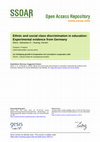
Research in Social Stratification and Mobility, 2019
Even though social class is at least as predictive of educational achievement as ethnicity in vir... more Even though social class is at least as predictive of educational achievement as ethnicity in virtually all developed countries, experimental research on discrimination in education has overwhelmingly focused on the latter. We investigate both ethnic discrimination and social class discrimination by elementary school teachers in Germany. We conceptualize discrimination as causal effects of signals and use directed acyclic graphs (DAGs) to disentangle ethnic from social class discrimination. In our experiment, we asked randomly sampled elementary school teachers who teach immigrants to evaluate an essay written by a fourth-grader. Employing a 2x2x3 factorial design, we varied essay quality, child's gender, and ethnic and socioeconomic background using names as stimuli. We do not find evidence for discrimination in grading. However, our findings for teachers' expectations of children's future performance suggest a discriminatory bias along the lines of both ethnicity and social class. The effect is conditional on essay quality-it only holds true for the better essay. We interpret our findings as evidence for models that highlight situational moderators such as the richness of information and ambiguity-e.g., statistical discrimination-but as evidence against simpler models of ingroup-favoritism or outgroup derogation, e.g., social identity theory or taste discrimination. 1. Introduction Race, ethnicity, and immigrant background are powerful predictors of educational achievement and attainment in virtually all developed countries, among which Germany shows comparatively large disparities between children with immigrant background-in particular those of Turkish descentand natives (
Advances in Biochemical Engineering/Biotechnology
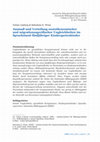
Journal for Educational Research Online, 2017
// English abstract
Inequalities in language competences may be more or less pronounced depending... more // English abstract
Inequalities in language competences may be more or less pronounced depending not only on the social or immigration background indicator under consideration , but can also diff er in size when looking at different positions of the competence distribution. Based on a nationwide sample of about 5-year-old preschool children this paper examines three research questions in this context: (1) To what extent are differences by social class, educational background, income, and immigrant background visible in children's vocabulary? (2) Do certain patterns of inequality exist along the distribution of competences? (3) To what extent can these patterns be explained by cumulative eff ects? These questions were investigated using quantile regression on data from the National Educational Panel Study (NEPS). The results show that diff erences are most pronounced with regard to parents' levels of formal education and their immigration background and concentrate in the lower areas of the competence distribution. In contrast, children of different socioeconomic and immigrant background diff er only little in higher quantiles of language competence. These patterns remain largely intact when controlling for covariates.
// Deutsches Abstract
Ungleichheiten im sprachlichen Kompetenzstand können nicht nur in Abhängigkeit des jeweils betrachteten Indikators der sozioökonomischen und migrationsspezifischen Herkunft unterschiedlich groß ausfallen, sondern auch an unterschiedlichen Stellen der Kompetenzverteilung mehr oder weniger stark aus-geprägt sein. Dieser Beitrag untersucht dazu drei Forschungsfragen anhand einer bundesweiten Stichprobe von etwa fünfjährigen Kindergartenkindern: (1) In wel-chem Ausmaß zeigen sich Ungleichheiten im Wortschatz von Kindergartenkindern ent lang sozialer Klasse, Bildungshintergrund, Haushaltseinkommen und Migrations hintergrund? (2) Lassen sich bestimmte Muster von Ungleichheiten ent-lang der Kompetenzverteilung erkennen? (3) Inwiefern lassen sich etwaige Muster durch kumulative Eff ekte erklären? Diese Fragen werden mittels Quantils regressionen anhand der Daten des Nationalen Bildungspanels (NEPS) analysiert. Die Ergebnisse zeigen, dass Ungleichheiten nach Bildungs-und Migrationshintergrund am größten ausfallen und sich vor allem auf den unteren Bereich der Leistungsverteilung konzentrieren. Dagegen unterscheidet sich der Wortschatz insbesondere der kompetentesten Kinder nur gering in Abhängigkeit der sozialen und migrationsspezifi schen Herkunft. Diese Muster bleiben auch un-ter Kontrolle von Kovariaten weitestgehend erhalten.
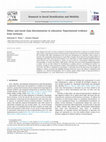
Research in Social Stratification and Mobility, 2020
Even though social class is at least as predictive of educational achievement as ethnicity in vir... more Even though social class is at least as predictive of educational achievement as ethnicity in virtually all developed countries, experimental research on discrimination in education has overwhelmingly focused on the latter. We investigate both ethnic discrimination and social class discrimination by elementary school teachers in Germany. We conceptualize discrimination as causal effects of signals and use directed acyclic graphs (DAGs) to disentangle ethnic from social class discrimination. In our experiment, we asked randomly sampled elementary school teachers who teach immigrants to evaluate an essay written by a fourth-grader. Employing a 2x2x3 factorial design, we varied essay quality, child's gender, and ethnic and socioeconomic background using names as stimuli. We do not find evidence for discrimination in grading. However, our findings for teachers' expectations of children's future performance suggest a discriminatory bias along the lines of both ethnicity and social class. The effect is conditional on essay quality-it only holds true for the better essay. We interpret our findings as evidence for models that highlight situational moderators such as the richness of information and ambiguity-e.g., statistical discrimination-but as evidence against simpler models of ingroup-favoritism or outgroup derogation, e.g., social identity theory or taste discrimination.
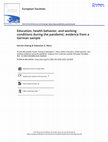
European Societies, 2020
Education is a main cause of health inequality because it influences health behavior as well as s... more Education is a main cause of health inequality because it influences health behavior as well as structural conditions that impact health, such as living and working conditions. We examine how different educational groups reacted to the beginning of the COVID-19 pandemic in Germany by looking at health-related behavior – social distancing, increased hygiene, and mask wearing – as well as changes in working conditions – work from home, reduced working hours, and not working – as a structural indicator that can mitigate the risk of infection. More than three quarters of respondents in all educational groups complied with recommended social distancing and hand hygiene behaviors, and differences by education did not exceed ten percentage points. Regarding working conditions, highly educated respondents had a likelihood of over 45 percent to work from home during the pandemic. This number decreased to 17 and 11 percent for those with intermediate and low levels of education, respectively. It seems that education-based inequalities in the risk of infection with COVID-19 do not primarily stem from differences in health behavior but rather from structural causes, that is, inability to practice social distancing at work.
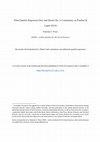
Child Development, 2019
Petscher and Logan (2014)’s description of quantile regression might mislead readers to believe i... more Petscher and Logan (2014)’s description of quantile regression might mislead readers to believe it would estimate the relation between an outcome, y, and one or more predictors, x, at different quantiles of the unconditional distribution of y. However, quantile regression models the conditional quantile function of y given x just as linear regression models the conditional mean function. This article’s contribution is twofold: First, it discusses potential consequences of methodological misconceptions and formulations of Petscher and Logan (2014)’s presentation by contrasting features of quantile regression and linear regression. Secondly, it reinforces the importance of correct understanding of quantile regression in empirical research by illustrating similarities and differences of various quantile regression estimators and linear regression using simulated data.

Zeitschrift Fur Erziehungswissenschaft, 2011
The German National Educational Panel Study covers educational processes during Kindergarten and ... more The German National Educational Panel Study covers educational processes during Kindergarten and elementary school age in two stages: “Kindergarten and transition to elementary school” and “elementary school and transition to lower secondary school.” One cohort covers both of these two stages, starting in winter 2010/2011 with a cluster sample of 3,000 target children at about age 4 in Kindergarten. When most of these children enter school, the cohort will be more than doubled by integrating their classmates into the survey. In addition to direct assessment of children’s competencies, their parents are interviewed and teachers and principals fill out self-administered questionnaires. In these stages, assessments focus on early scientific and mathematical literacy as well as language competencies (e.g., vocabulary, grammar, phonological awareness). We survey the structure and aspects of the quality of Kindergarten and elementary school, families, and nonformal learning environments. Information on parents’ socioeconomic status and their evaluation of decision-relevant aspects allows us to model school choice and disentangle primary and secondary effects of stratification. Theoretically relevant aspects of migrants’ situation are surveyed. Further aspects are children’s health, social competencies, and the different care settings. Bildungsprozesse im Kindergarten und in der Grundschule werden im Nationalen Bildungspanel durch zwei Etappen abgedeckt: „Kindergarten und Übergang in die Grundschule“ und „Grundschule und der Übergang zur Sekundarstufe“. Diese beiden Etappen haben eine gemeinsame Startkohorte, die im Winter 2010/2011 mit einer Clusterstichprobe von 3.000 Kindergartenkindern im Alter von ca. 4 Jahren startet. Bei der Einschulung dieser Kinder wird der Stichprobenumfang mehr als verdoppelt, da nun auch deren Mitschüler in die Studie aufgenommen werden. Zusätzlich zur direkten Erfassung der kindlichen Kompetenzen werden die Eltern der Kinder telefonisch befragt und die pädagogischen Fachkräfte und Leitungen der Kindergärten bzw. Schulen füllen Fragebögen aus. In den beiden Etappen werden primär frühe naturwissenschaftliche und mathematische Fähigkeiten sowie Sprachkompetenzen (z. B. Wortschatz, Grammatik, phonologische Bewusstheit, Lesekompetenz) erhoben. Zudem werden Struktur- und Qualitätsaspekte von Kindergärten, Grundschulen, Familien sowie von informellen/non-formalen Lernumwelten erfasst. Die Erfassung des sozioökonomischen Status der Eltern und deren Bewertung relevanter Aspekte von Schulwahlentscheidungen ermöglichen die analytische Unterscheidung zwischen primären und sekundären Effekten der sozialen Herkunft. Zudem werden theoriegeleitet migrationsrelevante Indikatoren von Kindern, Eltern und pädagogischen Fachkräften erhoben. Weitere erfasste Bereiche sind Sozialkompetenzen, der Gesundheitszustand und die Betreuungssituation der Kinder.





Uploads
Papers by Sebastian E Wenz
Inequalities in language competences may be more or less pronounced depending not only on the social or immigration background indicator under consideration , but can also diff er in size when looking at different positions of the competence distribution. Based on a nationwide sample of about 5-year-old preschool children this paper examines three research questions in this context: (1) To what extent are differences by social class, educational background, income, and immigrant background visible in children's vocabulary? (2) Do certain patterns of inequality exist along the distribution of competences? (3) To what extent can these patterns be explained by cumulative eff ects? These questions were investigated using quantile regression on data from the National Educational Panel Study (NEPS). The results show that diff erences are most pronounced with regard to parents' levels of formal education and their immigration background and concentrate in the lower areas of the competence distribution. In contrast, children of different socioeconomic and immigrant background diff er only little in higher quantiles of language competence. These patterns remain largely intact when controlling for covariates.
// Deutsches Abstract
Ungleichheiten im sprachlichen Kompetenzstand können nicht nur in Abhängigkeit des jeweils betrachteten Indikators der sozioökonomischen und migrationsspezifischen Herkunft unterschiedlich groß ausfallen, sondern auch an unterschiedlichen Stellen der Kompetenzverteilung mehr oder weniger stark aus-geprägt sein. Dieser Beitrag untersucht dazu drei Forschungsfragen anhand einer bundesweiten Stichprobe von etwa fünfjährigen Kindergartenkindern: (1) In wel-chem Ausmaß zeigen sich Ungleichheiten im Wortschatz von Kindergartenkindern ent lang sozialer Klasse, Bildungshintergrund, Haushaltseinkommen und Migrations hintergrund? (2) Lassen sich bestimmte Muster von Ungleichheiten ent-lang der Kompetenzverteilung erkennen? (3) Inwiefern lassen sich etwaige Muster durch kumulative Eff ekte erklären? Diese Fragen werden mittels Quantils regressionen anhand der Daten des Nationalen Bildungspanels (NEPS) analysiert. Die Ergebnisse zeigen, dass Ungleichheiten nach Bildungs-und Migrationshintergrund am größten ausfallen und sich vor allem auf den unteren Bereich der Leistungsverteilung konzentrieren. Dagegen unterscheidet sich der Wortschatz insbesondere der kompetentesten Kinder nur gering in Abhängigkeit der sozialen und migrationsspezifi schen Herkunft. Diese Muster bleiben auch un-ter Kontrolle von Kovariaten weitestgehend erhalten.
Inequalities in language competences may be more or less pronounced depending not only on the social or immigration background indicator under consideration , but can also diff er in size when looking at different positions of the competence distribution. Based on a nationwide sample of about 5-year-old preschool children this paper examines three research questions in this context: (1) To what extent are differences by social class, educational background, income, and immigrant background visible in children's vocabulary? (2) Do certain patterns of inequality exist along the distribution of competences? (3) To what extent can these patterns be explained by cumulative eff ects? These questions were investigated using quantile regression on data from the National Educational Panel Study (NEPS). The results show that diff erences are most pronounced with regard to parents' levels of formal education and their immigration background and concentrate in the lower areas of the competence distribution. In contrast, children of different socioeconomic and immigrant background diff er only little in higher quantiles of language competence. These patterns remain largely intact when controlling for covariates.
// Deutsches Abstract
Ungleichheiten im sprachlichen Kompetenzstand können nicht nur in Abhängigkeit des jeweils betrachteten Indikators der sozioökonomischen und migrationsspezifischen Herkunft unterschiedlich groß ausfallen, sondern auch an unterschiedlichen Stellen der Kompetenzverteilung mehr oder weniger stark aus-geprägt sein. Dieser Beitrag untersucht dazu drei Forschungsfragen anhand einer bundesweiten Stichprobe von etwa fünfjährigen Kindergartenkindern: (1) In wel-chem Ausmaß zeigen sich Ungleichheiten im Wortschatz von Kindergartenkindern ent lang sozialer Klasse, Bildungshintergrund, Haushaltseinkommen und Migrations hintergrund? (2) Lassen sich bestimmte Muster von Ungleichheiten ent-lang der Kompetenzverteilung erkennen? (3) Inwiefern lassen sich etwaige Muster durch kumulative Eff ekte erklären? Diese Fragen werden mittels Quantils regressionen anhand der Daten des Nationalen Bildungspanels (NEPS) analysiert. Die Ergebnisse zeigen, dass Ungleichheiten nach Bildungs-und Migrationshintergrund am größten ausfallen und sich vor allem auf den unteren Bereich der Leistungsverteilung konzentrieren. Dagegen unterscheidet sich der Wortschatz insbesondere der kompetentesten Kinder nur gering in Abhängigkeit der sozialen und migrationsspezifi schen Herkunft. Diese Muster bleiben auch un-ter Kontrolle von Kovariaten weitestgehend erhalten.